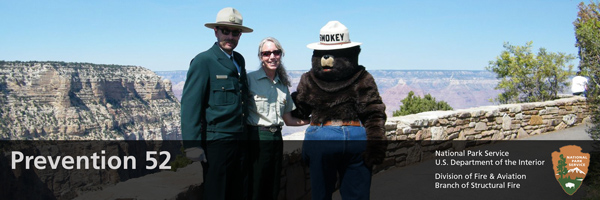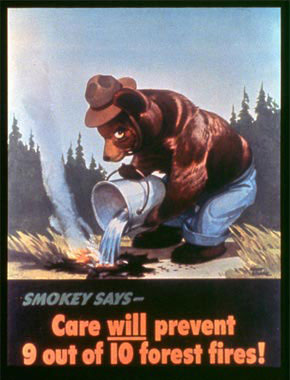Care will prevent 9 out of 10 forest fires! Smokey Bear


On August 9, 1944, Smokey Bear first appeared in a poster telling us, "Care will prevent 9 out of 10 forest fires!" Smokey continues to send a strong message that helps reduce human-caused wildfires. Sponsored by the Ad Council, the Smokey Bear campaign is the longest running public service campaign, and Smokey is one of the most recognizable characters ever created.
Smokey, for your birthday, I am going to give you the gift of fire prevention for your bear den. So take a break, you've earned it. I visited the National Fire Protection Association http://www.nfpa.org and found some very interesting statistics about structural fires that should help you prevent a fire in your bear den:
- In 2010, over 369,000 fires were reported in people's homes in the United States.
- Cooking is the leading cause of home fires, but heating equipment, electrical distribution, and smoking were also significant causes of home fires.
- Two-thirds of the people who died in a home fire did so in homes that had no smoke alarms or had smoke alarms that did not work.
Your friend Sparky at the National Fire Protection Association recommended that we all use the Home Fire Inspection Checklists he developed. Using this checklist as I toured your bear den, I noticed you had smoke alarms on each floor, but not in each bedroom. And one of the smoke alarms did not have a working battery. So I replaced the batteries in all of your smoke alarms. I also installed alarms in your bedrooms because you didn't have them. You should consider having a qualified contractor replace all of your smoke alarms with hardwired interconnected smoke alarms so that when one senses smoke, everyone in the house is alerted.
I was not surprised to see that you have all of your flammable liquids properly stored and of course your matches and lighters are safely stored in a secure cabinet. If anyone knows how to safely store a matchbook, it would be you! Your kitchen looks good with no towels hanging over your stove top, although with a diet of nuts and berries, I bet you don't use your stove much. Your chimney is clean, so that will help prevent any fires when you are hibernating next winter. I did find the lint filter in your dryer filled with lint from your blue jeans, so I cleaned it for you. To stay safe in your home, be sure to clean your dryer of lint after every load.
So happy birthday, Smokey, and remember...even YOU can prevent bear den fires!
Fire Info for You
Employees
- Download the home inspection form. Use the form to take a good look around your house for fire hazards. Consider involving your children in the exercise. Some local fire departments will do this for you, so you might want to call them as well.
- If you live in communal housing, such as a dormitory, make sure you know when the smoke alarms were last checked and be sure you know two ways to get out of the building in an emergency.
Park Leadership
- Past P52s have called for this action, but if you have not already done so, it is time to take a strong leadership role for the safety of your employees, partners, and visitors. Ensure that every building where someone sleeps has operating smoke detection, and make any necessary repairs, if needed.
- Housing managers, use the inspection form linked above to help ensure you have an adequate housing inspection program that includes structural fire hazards.
Regional/National Leadership
The data are clear: we know we can do better when it comes to providing housing and overnight accommodations that have working smoke detection. We must ensure through policy and leadership that all buildings designed for overnight occupancy are equipped with working smoke detection.
Take Action
Whether you live in a park house or a dormitory, or you retire nightly to your “den” away from the park, make sure you have operating smoke alarms and that your den is fire safe.
NPS Fire Facts
The structural fire program contracts with fire protection engineers to do fire and life safety building inspections. So far, we have inspected over 6,300 buildings in the national parks. Our data show that we have way too many buildings where people sleep that are missing smoke alarms or have smoke alarms that are not operating because the batteries were removed.
Last updated: October 20, 2016
